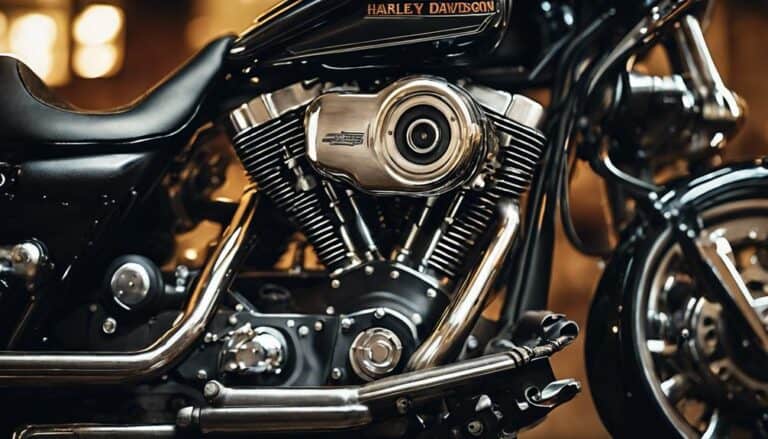Ever wondered how a Harley-Davidson engine, with its classic rumble, truly operates? At first glance, it may seem like a mystery, but rest assured, the inner workings are both fascinating and intricate.
From the synchronized dance of the four-stroke cycle to the orchestration of power and torque, each component plays a vital role in the symphony of performance. But what really sets this engine apart?
Curious to uncover the secrets behind its iconic sound and unparalleled durability?
Key Takeaways
- Harley engines operate on a precise four-stroke cycle for combustion efficiency.
- Power transfer involves components like the compensating sprocket and clutch system.
- Cooling is achieved through air-cooling and efficient lubrication with an oil system.
- Performance tuning tips include adjusting air/fuel mixture and upgrading key components for enhanced power.
Harley Davidson Engine Basics
In a Harley-Davidson engine, the combustion process follows a precise four-stroke cycle, each stage crucial for optimal performance and power delivery. The cycle starts with the intake stroke, where the piston moves down the cylinder, drawing in a mixture of air and fuel through the intake valve. As the piston ascends during the compression stroke, this mixture is compressed, preparing it for ignition. The spark plug then ignites the compressed air-fuel mixture, leading to combustion that forces the piston back down in the power stroke. This downward movement generates the power necessary to drive the motorcycle. Finally, in the exhaust stroke, the exhaust valve opens, and the piston pushes the remaining gases out of the cylinder through the exhaust valve.
Harley engines are renowned for their distinctive sound, a result of their firing sequence and design. By carefully balancing power and torque, Harley-Davidson offers a range of engine models to cater to different riding styles and preferences, ensuring a liberating experience on the road.
Four-Stroke Engine Operation
Engage with the intricate mechanics of a four-stroke engine, a fundamental aspect of understanding Harley-Davidson engine functionality. In the four-stroke cycle of a Harley Davidson engine, the process involves intake, compression, ignition, and exhaust strokes. This sequence ensures optimal combustion efficiency and power generation. Here's what happens during each stroke:
- Intake: The piston moves downward, drawing a mixture of air and fuel into the cylinder.
- Compression: The intake valve closes, and the piston moves upward, compressing the air-fuel mixture to increase its potency.
- Ignition: The spark plug ignites the compressed mixture, causing a controlled explosion that drives the piston downward.
This process is crucial in converting the potential energy of fuel into mechanical work, propelling the motorcycle forward. By regulating the intake and exhaust through valves and utilizing a spark plug for ignition, the Harley-Davidson engine achieves remarkable power output and performance.
Power Transfer Mechanism
Transitioning from the intricate mechanics of a four-stroke engine, delve into the power transfer mechanism of a Harley-Davidson engine, where power is efficiently transferred from the crankshaft to the transmission through the compensating sprocket and clutch system. The compensating sprocket, integral to this process, ensures the smooth transfer of power using a chain mechanism. Simultaneously, the clutch system, equipped with ramps, crevices, balls, and a diaphragm spring, facilitates the seamless engagement and disengagement of the engine from the transmission. Understanding these components is crucial for maintaining optimal performance. Regular maintenance practices are essential to uphold the longevity and efficiency of the power transfer mechanism. To emphasize the significance of maintenance, let's look at a comparison table showcasing the key components involved:
| Component | Function | Importance |
|---|---|---|
| Compensating Sprocket | Transfers power to transmission | Vital for power transfer |
| Clutch System | Enables engagement/disengagement of engine | Essential for operation |
| Maintenance Practices | Ensures longevity and efficiency | Critical for engine health |
Cooling and Lubrication Systems
The efficient operation of a Harley-Davidson engine relies heavily on its cooling and lubrication systems. Harley engines typically utilize air-cooling mechanisms instead of liquid cooling systems, simplifying the design and reducing weight. Cooling fins strategically placed on the engine aid in heat dissipation by increasing the surface area for efficient cooling.
Oil plays a crucial role in lubricating engine components, minimizing friction, and reducing wear on moving parts. The oil cooling system within Harley-Davidson engines is paramount in regulating temperatures to ensure optimal operating conditions, ultimately enhancing performance and promoting engine longevity.
Performance Tuning Tips
Harley-Davidson engine performance can be significantly enhanced through strategic adjustments to factors such as air/fuel mixture, airflow, and ignition timing. Improving combustion efficiency by tweaking the air/fuel mixture is a fundamental step in boosting power output.
Upgrading to high-flow air filters and exhaust systems can optimize engine breathing, resulting in increased performance. Installing a performance tuner allows for fine-tuning fuel delivery and ignition timing, enabling customization for maximum power gains.
High-performance camshafts can further elevate performance by enhancing valve lift and duration, promoting better engine efficiency. Dyno tuning plays a crucial role in the performance tuning process, as it allows precise adjustments to parameters like fuel mixture and ignition timing to achieve peak performance levels.
Conclusion
In conclusion, the Harley-Davidson engine is a marvel of engineering, combining precision and power to create a thrilling riding experience. From the rhythmic thump of the pistons to the roar of the exhaust, every aspect of the engine works in harmony to deliver unparalleled performance.
So, next time you rev up your Harley, remember the intricate workings beneath the surface that make it all possible. Ride on, and embrace the symphony of mechanical excellence.

